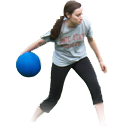
How to stay fit while injured or sick

My workouts are my “me-time.” They keep me grounded, help me focus, and make me feel good. I think many people consider their workout sessions a sort of personal therapy, so it’s no wonder that an extended hiatus would be challenging for multiple reasons.
With that said, recently I went through something that prevented me from exercising for eight weeks. I usually workout between 3-6 times a week, but a period of injury/illness/life stuff put me on an almost absolute hiatus. Afterwards, it took me a lot of patience, modifications and time to feel “normal” again. It was really challenging, in a lot of different ways. I thought that maybe I could turn my negative situation into a more positive one – or at least one that others can benefit from – by sharing my experience with managing a forced break from exercise.
No one is immune from sidelining events. There are innumerable reasons why one might be forced to take an extended rest period from exercise, and each of us will more than likely face this scenario on at least one occasion.
Injury, illness, and LIFE happens. How you handle these things makes all the difference. And that doesn’t necessarily mean buckling down and charging forward more intensely; it can also mean slowing down and letting yourself heal. Here are my suggestions for getting through a sidelining event.
You are not lazy, and this won’t last forever
Here’s something to tackle from the get-go, no matter what has sidelined your activity; there is a very big difference in between skipping workouts because you “don’t feel like it,” and because you’ve got an injury or doctor’s orders. Taking a break because you are ill or injured is not lazy, and it’s not something you should allow yourself to feel any guilt over whatsoever. You have to do what’s best for your health & body – and sometimes, rest is best. If you rest right the first time, you can sometimes cut down on your healing time, but if you deny yourself the chance to heal properly, you may find that your initial setback is a gift that keeps on giving. Get your mindset right and don’t get down on yourself – tell yourself; this is what I need, and I am going to do what I need to heal.
Do what you can
Here’s the thing; there’s almost always some activity you can do that will benefit your situation. It’s important to not be “too cool” for easier training while you’re down and out. However light or easy it might feel compared to the training you’re used to, anything is better than nothing and there’s a lot of stuff that you can continue to do that slows or reduces the diminishing of your baseline fitness during a break (think flexibility, range of motion, basic movement integrity work, etc.). You can always alter a routine to work around an injury, but if you need more strict rest, you could use this as an opportunity to focus on stretching and flexibility. Beginner or low impact routines may be good options, or you could even cut out physical activity entirely and work on mental fitness with meditation, if necessary. Be humble, and honest with yourself; what can you do without causing additional pain or discomfort? Do what you can, and be satisfied that you showed up. Even if the intensity is severely reduced for months at a time, you can make a much smoother reentry for yourself by doing the things that you are safely able to.
Body changes and the feeling of losing progress
If you make healthy food choices while you’re healing, you may be surprised at how relatively little of a change even a month or two of inactivity can have on your weight and body fat. Inactivity plus poor food choices will, unfortunately, add up a lot quicker. But, whether your body weight, composition, and capabilities change while you’re inactive, either way, there’s no reason to freak out. Let’s say you do gain weight or lose muscle and endurance; so what? It’s not like you aren’t sure how that happened; you know of the exact cause & effect. You took the necessary time off. There is no mystery variable there. So if you start to feel yourself backsliding, just remind yourself that a cool, calm head is much more likely to make healthy decisions than one that has already talked itself into failing. Soon, when you are healed, you will return to your workouts and your normal routines and body weight, strength and composition will also return to normal.
Focus on nutrition
While tough workouts are temporarily out, it’s especially important to make sure you’re eating healthily. It’s important for your healing, and eating well while you’re sidelined can help you avoid putting on extra weight while you are laid up.
Busy yourself with something new
With the extra time you have, do something else that you enjoy or find a new way to challenge yourself. I personally binged on a bunch of Netflix, read dozens of books and started writing again. You could find a new show you like, try and beat a video game, or get ambitious and constructive and learn a new hobby, a new language or study something that interests you.
Jump back in – slowly, and carefully
When you’re coming back from a long break, you should basically not assume anything about your body, or it’s capabilities. Be wide open to feedback, and listen to the messages that your body sends. Modify exercises, intensity, length, range of motion, etc. as you need to. It won’t help to rush anything, and in the end, the only real goal is good health. What could be more important than investing in your health?
Don’t let negative thoughts poison your return to workouts
While you’re getting back into the swing of things after a forced break, do not beat yourself up for the workouts you missed, or judge yourself for the bodily changes that inactivity inevitably brings. Don’t get mad if and when you struggle with something that felt easy a few months ago. Refuse those kinds of pointless ruminations; it’s a waste of energy, and it benefits no one. Dust yourself off and start again. Don’t let negative self-talk pollute your workout space. There’s no room for it.
It can be surprisingly hard to take time off from an exercise routine. It feels good to push and improve yourself, and exercise is a great way to manage life stress, but sometimes, rest is what we need the most.
Article by Fitness Blender
The Arena District Athletic Club is more than just a gym; it’s a premier fitness facility located in the heart of the Arena District in downtown Columbus. We provide convenience and quality, featuring top-of-the-line equipment, top-notch personal trainers, spa-like locker rooms and a wide variety of free group fitness classes daily including Cardio, Spinning, Barre Fusion, Yoga, Boot Camp and more. We offer free 2-hour parking and convenient contract-free memberships, to fit your healthy lifestyle needs. Don’t just join, belong.




